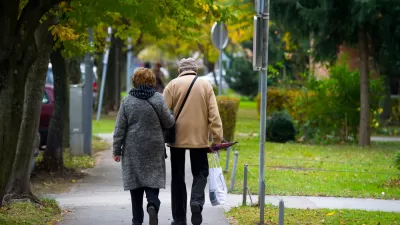It's not just the Sun Cities of America that are planning for how to meet the needs of the country's coming bulge in its over-65 population. Ryan Holeywell highlights how some cities are adapting their built environments for an aging population.
Widened sidewalks, crouching buses, safer crosswalks, senior bicycling groups, and zoning changes to allow "granny flats" are just a sample of the ways in which communities across America are planning to meet the needs of the 80+ percent of baby boomers who plan to age in place.
"Across the country, urban planners and transit officials are realizing
that the wave of boomer retirees will transform the way cities look,
from the way they grow and sprawl to minutiae such as curb heights and
the fonts on street signs," writes Holeywell.
"We're in a period of transition that's
pretty dramatic," says David Dixon, who leads the planning and urban
design practice at the Boston-based firm Goody Clancy. "You look at
major metro areas, and sometimes a third or more of their growth for the
next 30 years is folks over 65. That's a hugely [significant] and rapid
transition."
"The bottom line, planners say, is that city and county governments face a
growing challenge: how to design a community for a population they
haven't had to cater to in the past. If they come up with the right
answer, they can help aging residents lead fulfilling lives and remain
engaged and active, even in their senior years. But if they fail, they
risk alienating and isolating a rapidly growing cohort of taxpayers."
FULL STORY: How Will Boomers Reshape U.S. Cities?

Alabama: Trump Terminates Settlements for Black Communities Harmed By Raw Sewage
Trump deemed the landmark civil rights agreement “illegal DEI and environmental justice policy.”

Study: Maui’s Plan to Convert Vacation Rentals to Long-Term Housing Could Cause Nearly $1 Billion Economic Loss
The plan would reduce visitor accommodation by 25% resulting in 1,900 jobs lost.

Planetizen Federal Action Tracker
A weekly monitor of how Trump’s orders and actions are impacting planners and planning in America.

Wind Energy on the Rise Despite Federal Policy Reversal
The Trump administration is revoking federal support for renewable energy, but demand for new projects continues unabated.

Passengers Flock to Caltrain After Electrification
The new electric trains are running faster and more reliably, leading to strong ridership growth on the Bay Area rail system.

Texas Churches Rally Behind ‘Yes in God’s Back Yard’ Legislation
Religious leaders want the state to reduce zoning regulations to streamline leasing church-owned land to housing developers.
Urban Design for Planners 1: Software Tools
This six-course series explores essential urban design concepts using open source software and equips planners with the tools they need to participate fully in the urban design process.
Planning for Universal Design
Learn the tools for implementing Universal Design in planning regulations.
Caltrans
Smith Gee Studio
Institute for Housing and Urban Development Studies (IHS)
City of Grandview
Harvard GSD Executive Education
Toledo-Lucas County Plan Commissions
Salt Lake City
NYU Wagner Graduate School of Public Service





























